Related Research Articles

The Standard Works of the Church of Jesus Christ of Latter-day Saints are the four books that currently constitute its open scriptural canon. The four books of the standard works are:

The Dicastery for the Doctrine of the Faith (DDF) is a department of the Roman Curia in charge of the religious discipline of the Catholic Church. The Dicastery is the oldest among the departments of the Roman Curia. Its seat is the Palace of the Holy Office in Rome. It was founded to defend the Catholic Church from heresy and is the body responsible for promulgating and defending Catholic doctrine.
This is an index page of Wikipedia articles related to the topic of religion.
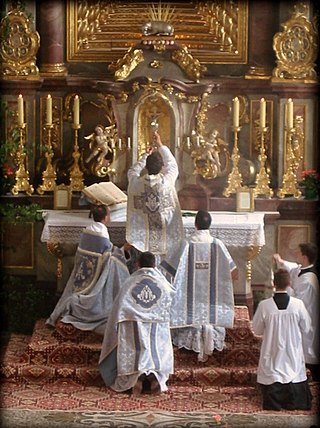
Traditionalist Catholicism is a movement that emphasizes beliefs, practices, customs, traditions, liturgical forms, devotions and presentations of teaching associated with the Catholic Church before the Second Vatican Council (1962–1965). Traditionalist Catholics particularly emphasize the Tridentine Mass, the Roman Rite liturgy largely replaced in general use by the post-Second Vatican Council Mass of Paul VI.
A guardian angel is a type of angel that is assigned to protect and guide a particular person, group or nation. Belief in tutelary beings can be traced throughout all antiquity. The idea of angels that guard over people played a major role in Ancient Judaism. In Christianity, the hierarchy of angels was extensively developed in the 5th century by Pseudo-Dionysius the Areopagite. The theology of angels and tutelary spirits has undergone many changes since the 5th century. The belief is that guardian angels serve to protect whichever person God assigns them to. The Memorial of the Holy Guardian Angels is celebrated on 2 October.

The Prayer to Saint Michael the Archangel usually refers to one specific Catholic prayer to Michael the Archangel, among the various prayers in existence that are addressed to him. It falls within the realm of prayers on spiritual warfare. From 1886 to 1964, this prayer was recited after Low Mass in the Catholic Church, although not incorporated into the text or the rubrics of the Mass. Other prayers to Saint Michael have also been officially approved and printed on prayer cards. Prayer to St. Michael the Archangel by Pope Leo XIII:
Saint Michael the Archangel, defend us in battle; be our protection against the wickedness and snares of the devil. May God rebuke him, we humbly pray: and do thou, O Prince of the heavenly host, by the power of God, thrust into hell satan and all of the other evil spirits who prowl about the world seeking the ruin of souls. Amen

Emmanuel Milingo is an excommunicated former Roman Catholic archbishop from Zambia. He was ordained in 1958; in 1969, aged 39, Milingo was consecrated by Pope Paul VI as the bishop of the Archdiocese of Lusaka. In 1983, he stepped down from his position as Archbishop of Lusaka after criticism for exorcism and faith healing practices that were not approved by church authorities. In 2001, when Milingo was 71, he received a marriage blessing from Sun Myung Moon, the leader of the Unification Church, despite the prohibition on marriage for ordained priests. In July 2006, he established Married Priests Now!, an advocacy organization to promote the acceptance of married priests in the Roman Catholic Church.
Ecclesia Dei is the document Pope John Paul II issued on 2 July 1988 in reaction to the Ecône consecrations, in which four priests of the Society of Saint Pius X were ordained as bishops despite an express prohibition by the Holy See. The consecrating bishop and the four priests consecrated were excommunicated. John Paul called for unity and established the Pontifical Commission Ecclesia Dei to foster a dialogue with those associated with the consecrations who hoped to maintain both loyalty to the papacy and their attachment to traditional liturgical forms.

In Christian theology, a private revelation is an instance of revelation, in a broader sense of the term, of divine reality to a person or persons. It contrasts with revelation intended for humanity at large, which is sometimes termed public revelation.

The Marian Movement of Priests (MMP) is a private association of Catholic clergy and lay associate members founded by Italian priest Fr. Stefano Gobbi in 1972. According to the MMP, its members now include over 400 Catholic cardinals and bishops, more than 100,000 Catholic priests, and several million lay Catholics worldwide.

The Canons Regular of the Holy Cross of Coimbra are a Catholic religious order of canons regular founded in Portugal in the 12th century. The ORC follows the Rule of Saint Augustine.
William H. Stetson was a Roman Catholic priest of the Prelature of Opus Dei ordained in 1962. He was an honorary prelate of the Pope with the title of Reverend Monsignor. He lived in Los Angeles, California.

In the Catholic Church, a bishop is an ordained minister who holds the fullness of the sacrament of holy orders and is responsible for teaching doctrine, governing Catholics in his jurisdiction, sanctifying the world and representing the Church. Catholics trace the origins of the office of bishop to the apostles, who it is believed were endowed with a special charism and office by the Holy Spirit at Pentecost. Catholics believe this special charism and office has been transmitted through an unbroken succession of bishops by the laying on of hands in the sacrament of holy orders.

Velasio de Paolis, C.S., JCD, STL, was an Italian member of the Missionaries of St. Charles Borromeo (Scalabrinians) and a cardinal of the Catholic Church. He was President of the Prefecture for the Economic Affairs of the Holy See and Pontifical Delegate for the religious institute of the Legionaries of Christ.
The canonical situation of the Society of Saint Pius X (SSPX), a group founded in 1970 by Archbishop Marcel Lefebvre, is unresolved. The Society of Saint Pius X has been the subject of much controversy since 1988, when Bernard Fellay, Bernard Tissier de Mallerais, Richard Williamson and Alfonso de Galarreta were illicitly consecrated as bishops at Ecône, at the International Seminary of Saint Pius X, in violation of canon law. Lefebvre and the four other SSPX bishops individually incurred a disciplinary latae sententiae excommunication for this schismatic act. The excommunications of the four living SSPX bishops were remitted in 2009.
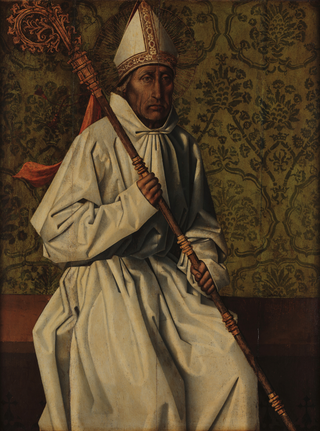
Theotonius was a Canon Regular and royal advisor. He is noted in Portugal, for being the first prior of the Monastery of the Holy Cross in Coimbra, Portugal. He is celebrated as the reformer of religious life in Portugal, and is the first Portuguese saint.
This is a glossary of terms used within the Catholic Church. Some terms used in everyday English have a different meaning in the context of the Catholic faith, including brother, confession, confirmation, exemption, faithful, father, ordinary, religious, sister, venerable, and vow.
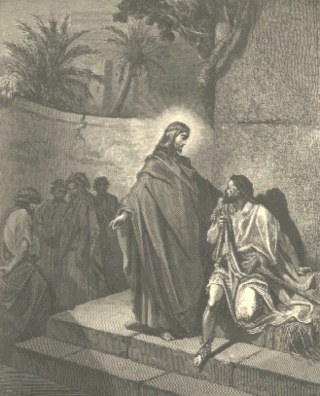
In Christianity, exorcism involves the practice of casting out one or more demons from a person whom they are believed to have possessed. The person performing the exorcism, known as an exorcist, is often a member of the Christian Church, or an individual thought to be graced with special powers or skills. The exorcist may use prayers and religious material, such as set formulas, gestures, symbols, icons, or amulets. The exorcist often invokes God, Jesus, angels and archangels, and various saints to aid with the exorcism. Christian exorcists most commonly cast out demons in Jesus' name.
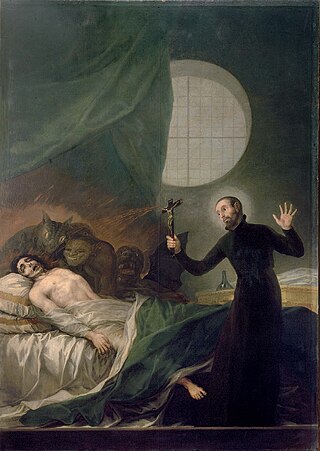
The Catholic Church authorizes the use of exorcism for those who are believed to be the victims of demonic possession. Initial guidelines were issue in 1614. In Roman Catholicism, exorcism is a sacramental but not a sacrament, unlike baptism or confession. Unlike a sacrament, exorcism's "integrity and efficacy do not depend ... on the rigid use of an unchanging formula or on the ordered sequence of prescribed actions. Its efficacy depends on two elements: authorization from valid and licit Church authorities, and the faith of the exorcist." The Catechism of the Catholic Church states: "When the Church asks publicly and authoritatively in the name of Jesus Christ that a person or object be protected against the power of the Evil One and withdrawn from his dominion, it is called exorcism."
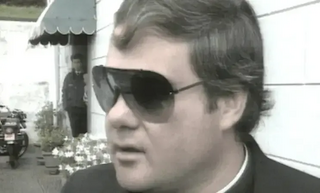
Frederico Marcos da Cunha usually referred to in the media as Father Frederico is a defrocked Brazilian Catholic priest and fugitive, convicted of murdering a teenager in Portugal, as well as sexually abusing numerous children and adolescents. He escaped from prison in 1998, and has been living as a free man in his native country ever since.
References
- 1 2 3 Holdren, Alan. "Controversial angels' order given Vatican OK", Catholic News Agency, 5 November 2010
- ↑ Introvigne, Massimo. (1999). The Labelling of Certain Catholic and "Fringe Catholic" Movements as Cults. Center for Studies on New Religions
- 1 2 Congregation for the Doctrine of the Faith, "Circular Letter to the Presidents of the Episcopal conferences Regarding the Association Opus Angelorum, 2 October 2010
- 1 2 Relinfo Switzerland, 1998 (see "Statistik"). Retrieved 1 January 2020
- 1 2 Relinfo Switzerland, 2020 (see "Statistik"). Retrieved 1 January 2020
- ↑ Opus Sanctorum Angelorum: About Us and Our Mission
- ↑ Order of the Canons Regular of the Holy Cross
- ↑ Canons Regular of the Holy Cross: Our Communities
- ↑ Code of Canon Law, canons 298–329
- ↑ Rosemary Ellen Guiley, The Encyclopedia of Angels (Visionary Living, Inc., 2004), p. 103
- ↑ Membership in Opus Sanctorum Angelorum
- 1 2 "Opus Angelorum", L'Osservatore Romano (English edition), 23 March 2011
- ↑ Opera dei Santi Angeli: La nostra storia
- ↑ Decree Litteris diei of 6 June 1992 on the Teaching and Particular Usages of the Opus Angelorum Association
- ↑ History of the Order of the Holy Cross
- ↑ Order of Canons Regular of the Holy Cross (O.R.C.)
- ↑ "Storia dell'Opera dei Santi Angeli". Archived from the original on 17 October 2010. Retrieved 6 November 2010.
- ↑ Jörg Schindler: Zurück im Schoß der Kirche., 10 October 2010
- ↑ Christian Lichtenstern, "Ingo Dollinger ist tot" in Augsburger Allgemeine , 16 June 2017
- ↑ Mariat: "Wer hat das 'Engelwerk' (Opus Angelorum) wirklich gegründet?" in the Augsburger Allgemeine , 1 June 2014. Retrieved 26 October 2018 from archive.org
- ↑ Facebook: Heinz Gstrein
- ↑ Roman Hanig, "Die dämonische Hierarchie des Engelwerks" in Münchener Theologische Zeitschrift 49,3 (1998)
- ↑ Heinz Gstrein: Engelwerk oder Teufelsmacht? Edition Tau, Mattersburg-Katzelsdorf (Austria) 1990, ISBN 3-900977-07-0, p. 170.
- ↑ Martin Haidinger; Heiner Boberski; Peter Gnaiger; Thomas Schaller; Robert Weichinger (2005). Mächtig - Männlich - Mysteriös: Geheimbünde in Österreich. Ecowin Verlag. p. 157. ISBN 978-3-7110-5033-5.
- ↑ Barbara Hans: Katholische Sekte Engelwerk: "Die haben unsere Tochter kaputtgemacht." Der Spiegel, 14 October 2010. Retrieved 16 March 2021
- ↑ Initiative engelwerkgeschädigter Familien (official web site, German). Retrieved 16 March 2021
- 1 2 Manuel Catarino, "Os pecados mortais do padre Frederico" in Correio da Manhã , 6 May 2006. Archived 12 December 2013, retrieved 23 October 2018
- 1 2 Carlos Diogo Santos, "A nova vida do padre Frederico" in Sol , 24 July 2015. Retrieved 25 August 2019]
- ↑ Renata Giraldi, Isabel Clemente: "Padre preso em Portugal foge para o Brasil" in Folha de S. Paulo , 10 April 1998. Retrieved 23 October 2018
- ↑ Miguel Fernandes Luís: "Padre Frederico escapa ao castigo" in Diário de Notícias , 4 March 2018. Retrieved 22 October 2018
- ↑ César Príncipe: Ementas do Paraíso: uma cruzada contra os infiéis do fast-food. Campo das Letras, Porto 2004, page 269
- ↑ Walter Axtmann: Engelwerk: Mord auf Madeira. In: Kirche intern, May 1995, pages 41–42.
